Khanjar: Its Craftsmanship and Significance
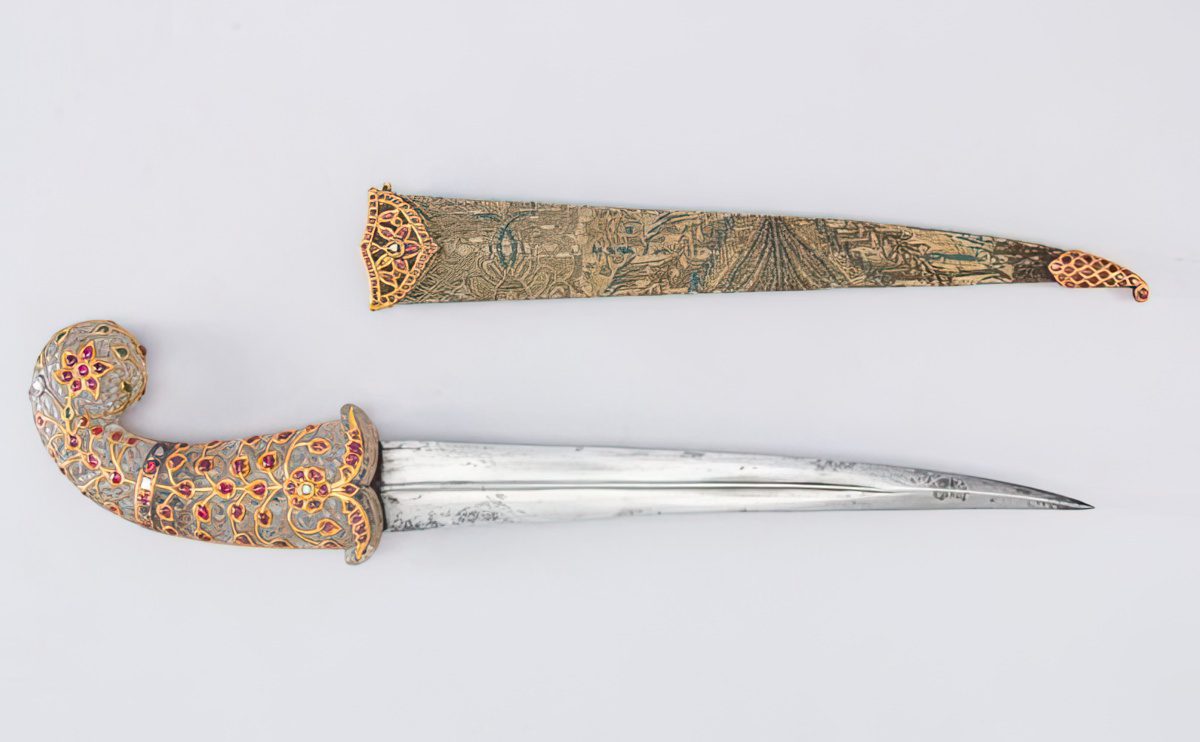
What’s in this article?
The khanjar dagger has been recognized for its craftsmanship for hundreds of years. Throughout history, it served as a status symbol and an all-purpose weapon for fighting and hunting. Today, it plays a crucial role in many Omani customs, traditions, and is still worn as part of their ceremonial dress on formal occasions.
Let’s explore the craftsmanship of the khanjar, what sets it apart from other Arabian daggers, and its significance in Omani culture.
Characteristics of the Khanjar Dagger
The khanjar is recognized for its slightly curved blade, though its hilt forms and decorations vary from region to region.
Here are the unique characteristics of the khanjar dagger:
Metal and Construction
Khanjar blades widely vary in their quality depending on their origin. Indian and Persian ones often had a wootz steel blade—or damascus steel of the pre-industrial era. Modern-day Omani khanjar daggers have locally-made blades and are widely produced in Sur and Nizwa cities in Oman.
Blade Appearance
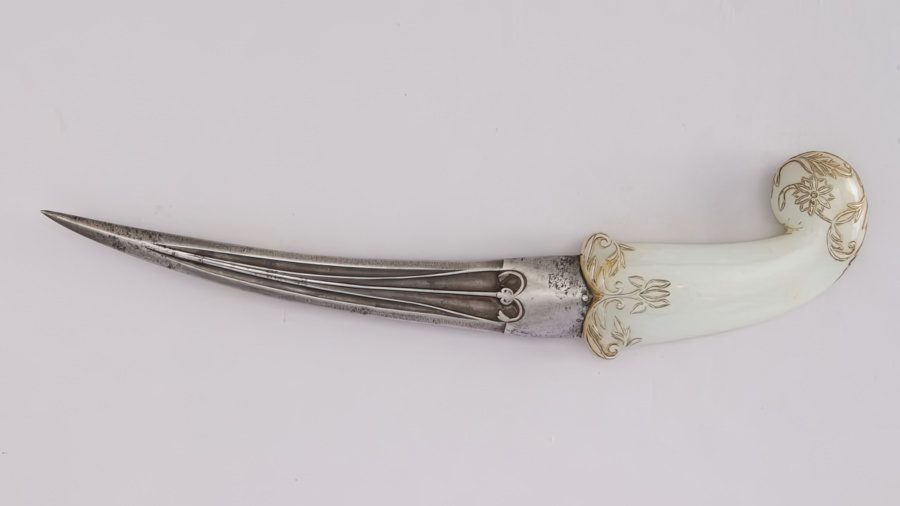
A khanjar has a double-edged steel blade, ranging from slightly curved to double-curved forms. Some have a broad base, gradually tapering to a point, while others are relatively slender. Also, the Omani khanjar blade is not as curved as its scabbard. Many feature a central ridge and a diamond cross-section.
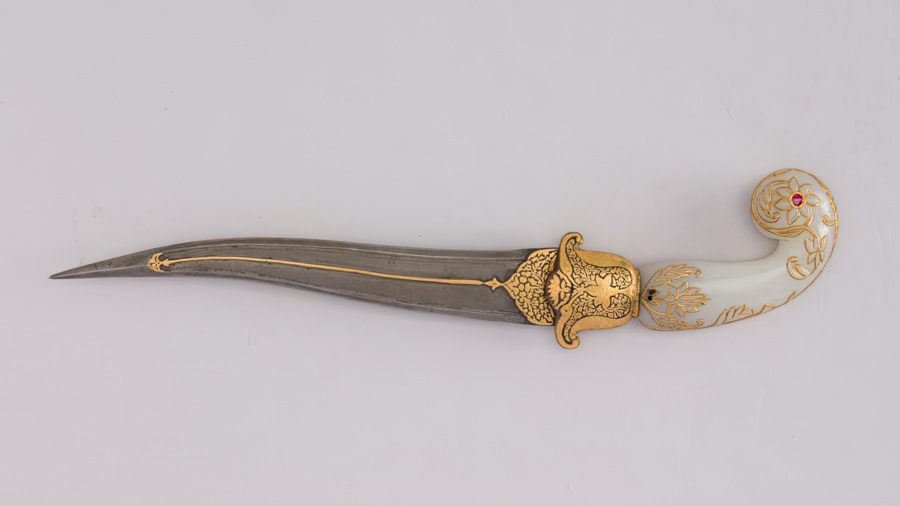
Indian and Persian blades also tended to be more highly decorated than others. Most Indian khanjar had gold inlay or overlay decorations on the blade, while Persian ones were often chiseled.
Size and Length
The khanjar dagger has an overall length ranging from 27 to 41 centimeters (11 to 16 inches) and a blade length of about 17 to 29 centimeters (6 to 11 inches).
Daggers below five inches are for children.
Sword Mounting
The khanjar dagger widely varies in hilt and scabbard designs. Materials and decorations used for the mounts also vary due to regional preferences.
Hilt

Indian khanjar daggers typically had jade hilts carved or inlaid with gemstones. On the other hand, early Omani khanjars were made from ivory and rhinoceros horn, but modern-made ones are usually of camel bone and wood.
I-Shaped Hilt
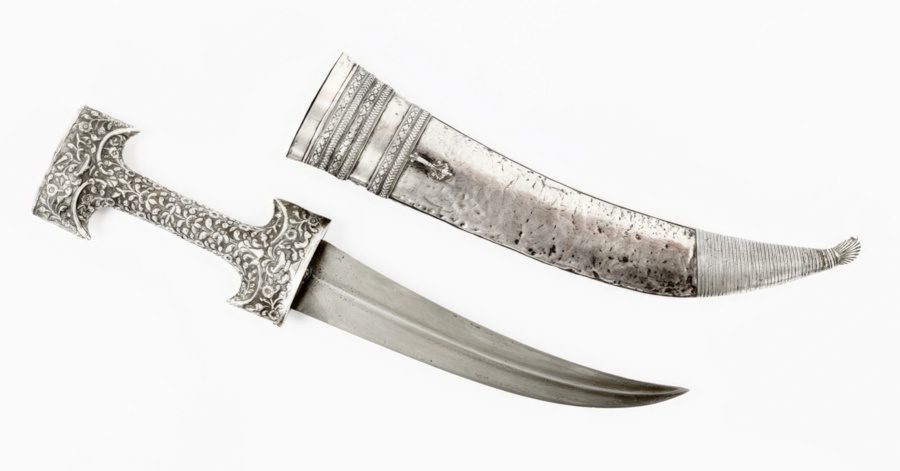
The typical Persian khanjar has an I-shaped hilt without a separate guard. The term hançer is the Turkish version of the Arabic word khanjar. Hançer daggers show the superior craftsmanship of the Ottomans, and some have an Arabic-inspired form. Bands of silver wire braids and high-relief designs are among the distinctive features of Ottoman craftsmanship.
Pistol-Shaped Hilt
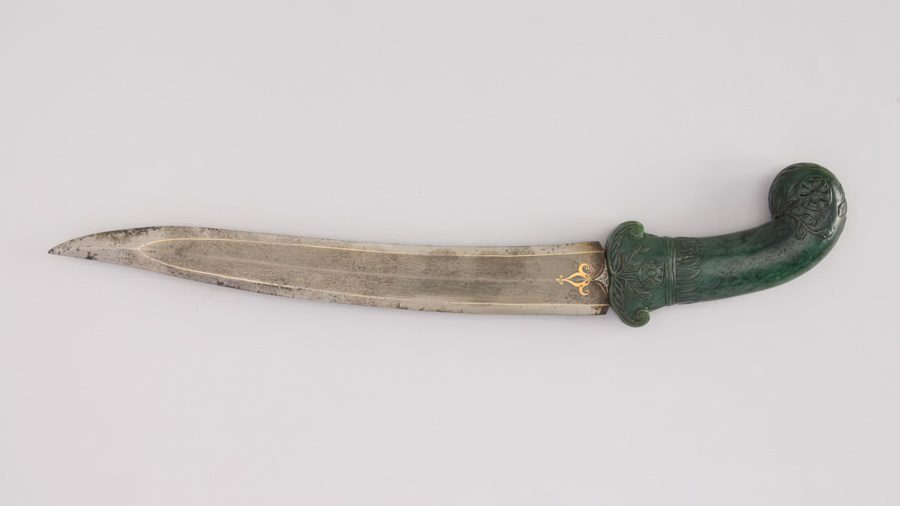
Most Indian and Persian khanjar daggers have pistol-shaped hilts. These grips are often made of jade and carved with flowers, leaves, and fern-like designs. In the 18th century, jade hilts inlaid with diamonds, rubies, emeralds, and pearls were traditional in Mughal courts. Many of these were made using the Indian kundan technique of setting gemstones.
Zoomorphic Hilt
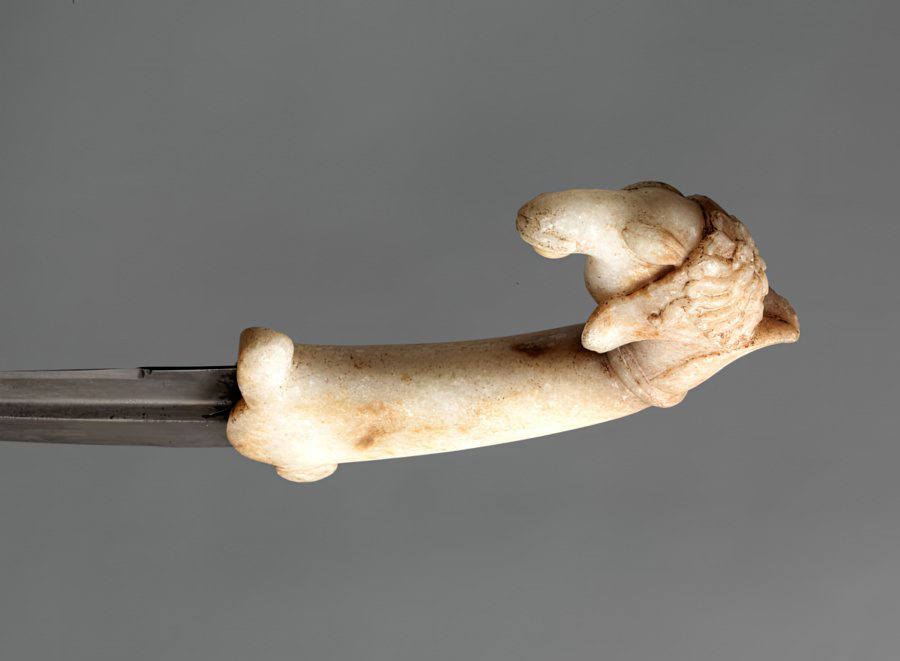
Zoomorphic hilts feature an animal’s head on the pommel, such as a horse, lion, sheep, blue bull, or parrot. These hilts are very refined and stylized, making the dagger a piece of sculpture. Often produced at the Mughal court, animal-headed hilts show the appreciation for nature by Mughal artists.
Flower-Shaped Hilt
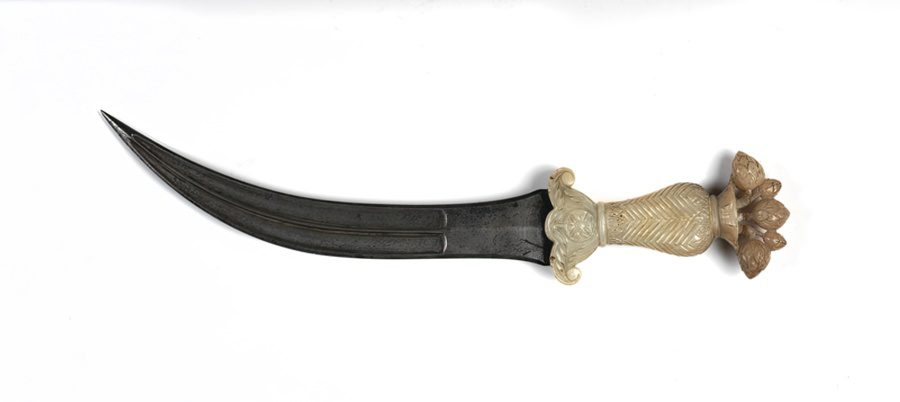
Some khanjar daggers have hilts carved to depict a flower in bloom. Most were made of carved jade and rarely wood, usually depicting lotus or iris.
Scabbard
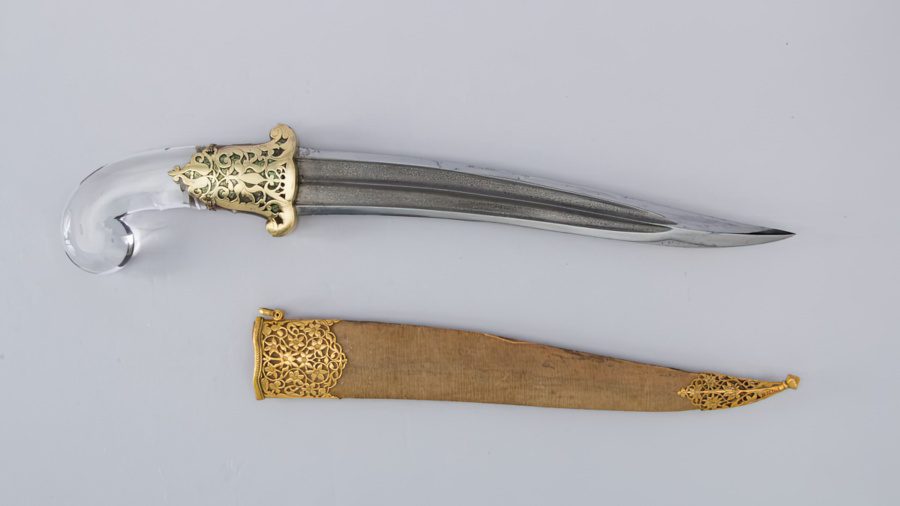
The scabbard is usually made of wood, covered with leather, velvet, steel, silver, or gold. Persian and Indian khanjar daggers have scabbards often mounted to match the hilt. Some scabbards were lacquered, enameled, or decorated with gold threads, seed pearls, and gemstones.
The Omani khanjar is distinguished for its J-shaped scabbard, distinguishing it from other Arabian sheaths. It sometimes has a leather sheath hand-stitched together using soft silver or gold thread.
Etymology and Collector’s Jargon
Khanjar (خنجر), plural form khanajir, is the Persian word for dagger. The term was widely used in regions with strong Persian influence, including Ottoman Turkey and North India. Today, it is the term mainly used in Eastern Arabia, such as in Muscat, Oman; Eastern Saudi Arabia; United Arab Emirates; and parts of Hadhramaut. It is also used in parts of the Middle East, particularly in Iraq and Syria.
On the other hand, jambiya is the term used for dagger, usually of all shapes and sizes, in the western parts of Arabia, mainly in Yemen and Western Saudi Arabia. Most Yemeni people consider the term khanjar standard Arabic, while jambiya (locally spelled janbiya) is a Yemeni term. However, both words are common in Eastern Yemen and Western Oman as people have moved frequently within these regions.
In Oman, what Western collectors call a jambiya is also referred to as khanjar. Some historians claim that the interchangeable use of these terms would be inaccurate, as khanjar is East Arabian, while jambiya is West Arabian. However, the khanjar should not be confused with the khanjarli—an Indian dagger with a large lunette pommel—and a development of the earlier chilanum dagger.
Historical Significance of the Khanjar Dagger
The khanjar daggers were one of the essential accessories for Mughal men. They are also the traditional weapons of the Omani people, and men wear them on formal occasions and ceremonial events throughout the country.
In India
The khanjar daggers in India showed the power and wealth of their owners. Deccan Sultans, Mughal emperors, and lower nobility wore them. Ornate daggers were traditionally worn at court to symbolize status and exchanged among Indian rulers as a token of favors.
The use of jade in khanjar hilts became common during the reign of Mughal emperor Aurangzeb, from 1658 to 1707, after trade routes into modern-day Hotan in China became accessible to the Mughal court.
In Persia
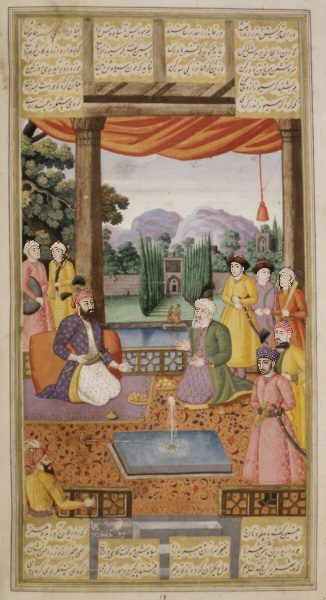
The khanjar was used in Persia from about the 15th century until the early 19th century. Most surviving examples can be traced back to the Qājār dynasty from 1794 to 1925. The Persians wore the khanjar daggers on the right side of the waist, tucked in a belt or sash. Sometimes, it was worn with the kard dagger on the front or left side.
In Modern-Day Oman
Once a self-defense weapon, the khanjar dagger became the symbol of national pride in Oman. It is even part of the national emblem and appears on the Omani flag. It is one of the gifts the Omani people give to official guests to show the cultural connection between nations. It also plays a significant role in many Omani customs and traditions.
The khanjar dagger is part of men’s traditional attire and is still worn today during religious, ceremonial, and national events. Omani men wear them during special occasions like weddings and family gatherings. It is also a popular accessory during the Eid holidays and the Hajj pilgrimage to Mecca.
The khanjar is one of the most intricately crafted items in Oman. The skills of making the dagger are passed from generation to generation and shared with immigrants in the country. UNESCO even declared the Omani khanjar worthy of preservation.
Conclusion
Ornamental daggers, especially the khanjar, were prized in the Arab-Muslim world. They served as a status symbol and a weapon and now symbolize the national pride of Oman. They remain part of the traditional dress worn by Omani men during religious and national events throughout the country.




